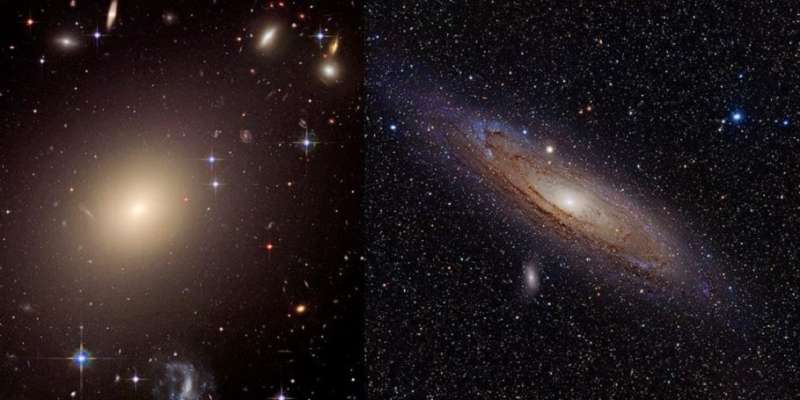Shedding light on galaxy rotation secrets

The dichotomy concerns the so-called angular momentum (per unit mass) that in physics is a measure of size and rotation velocity. Spiral galaxies are found to be strongly rotating, with an angular momentum higher by a factor of about five than ellipticals. What is the origin of such a difference? An international research team investigated the issue in a study just published in the Astrophysical Journal. The team was led by SISSA Ph.D. student JingJing Shi under the supervision of Prof. Andrea Lapi and Luigi Danese, and in collaboration with Prof. Huiyuan Wang from USTC (Hefei) and Dr. Claudia Mancuso from IRA-INAF (Bologna). The researchers inferred from observations the amount of gas fallen into the central region of a developing galaxy, where most of the star formation takes places.
The outcome is that in elliptical galaxies, only about 40 percent of the available gas fell into that central region. More relevantly, this gas fueling star formation was characterized by a rather low angular momentum. This is in stark contrast with the conditions found in spirals, where most of the gas that ends up in stars has an appreciably higher angular momentum. The researchers have traced the dichotomy in the angular momentum of spiral and elliptical galaxies to their different formation histories. Elliptical galaxies form most of their stars in a fast collapse in which angular momentum is dissipated. This process is likely stopped early on by powerful gas outflows from supernova explosions, stellar winds and possibly even from the central supermassive black hole. For spirals, on the other hand, the gas fell slowly, conserving its angular momentum, and stars formed steadily along a timescale comparable to the age of the universe.
"Until recent years, in the paradigm of galaxy formation and evolution, elliptical galaxies were thought to have formed by the merging of stellar disks in the distant universe. Along this line, their angular momentum was thought to be the result of dissipative processes during such merging events," the researchers write. Recently, this paradigm had been challenged by far-infrared/sub-millimeter observations brought about by the advent of space observatories like Herschel and ground-based interferometers like the Atacama Large Millimeter Array (ALMA).
These observations have the power of penetrating through interstellar dust thus unveiling the star formation processes in the very distant, dusty galaxies that constituted the progenitors of local ellipticals. "The net outcome from these observations is that the stars populating present-day ellipticals are mainly formed in a fast dissipative collapse in the central regions of dusty star-forming galaxies. After a short timescale of less than 1 billion years, the star formation has been quenched by powerful gas outflows." Despite this change of perspective, the origin of the low angular momentum observed in local ellipticals remained unclear.
"This study reconciles the low angular momentum observed in present-day ellipticals with the new paradigm emerging from Herschel and ALMA observations of their progenitors," conclude the scientists. "We demonstrated that the low angular momentum of ellipticals is mainly originated by nature in the central regions during the early galaxy formation process, and not nurtured substantially by the environment via merging events, as envisaged in previous theories."
More information: J. Shi et al. Angular Momentum of Early- and Late-type Galaxies: Nature or Nurture?, The Astrophysical Journal (2017). DOI: 10.3847/1538-4357/aa7893
Journal information: Astrophysical Journal
Provided by International School of Advanced Studies (SISSA)





















